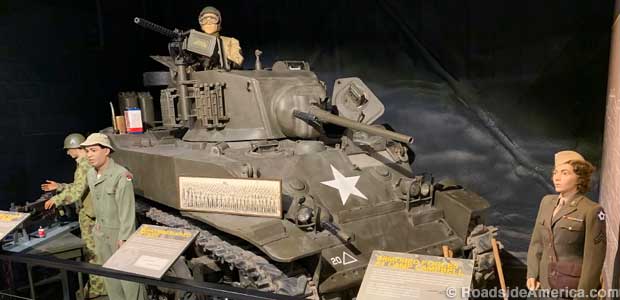
Fort Campbell, whose modern role is "envelopment warfare," began as a WWII armor training camp.
Pratt Museum: Atomic Mortar, Hitler's Stick
Fort Campbell, Kentucky
As an on-post museum, Fort Campbell's Don F. Pratt Museum focuses most of its attention on the military units assigned to Fort Campbell. Those units have fought battles from Nazi Germany to Afghanistan, which gives the collection an impressive array of guns, equipment, and warfare mementoes: including the bronzed paratrooper boots of William Lee (father of the 101st Airborne Division) and the walking stick of Hitler.
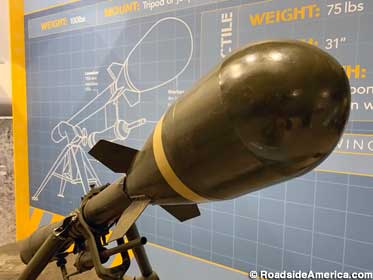
The atomic mortar was a nuclear menace to everybody.
Fort Campbell itself has a noteworthy history, and if visitors ask questions (as they should at any museum) they'll discover some quirky odds and ends.
"At one time, about one third of the nation's nuclear weapons were stored here," said museum director John O'Brien. The Fort had its own "Broken Arrow" team, a real-life version of the Hollywood Men in Black, trained to scrub nuclear accident scenes without alerting the press or the public. The Broken Arrow team came in handy during the exploding dog crisis of the early 1960s.
The University of Chicago wanted to look at the effects of gamma radiation on organic material, so the staff at the X-10 Reactor at Oak Ridge, Tennessee, obligingly irradiated some dogs who, unfortunately, died. The dogs, packed into 55 gallon drums, were loaded on a flatbed truck and a courier was ordered to drive them to Chicago -- and Fort Campbell was roughly midway between the the reactor and Chicago. "He had a girlfriend just outside the Fort, in Clarksville," said John. "She worked at a hamburger stand and he stopped to visit her at lunchtime." That's when the drums, left baking in the hot July sun, exploded. "It was a nuclear mess," said John. Fort Campbell's Broken Arrow team cleaned up the parking lot and buried the exploded dogs at the Fort. Their graves -- off-limits to visitors -- are still monitored by the EPA.
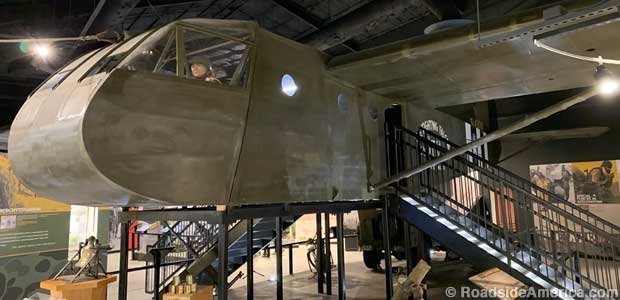
The ride inside a Waco Glider was compared to sitting inside a pounding bass drum.
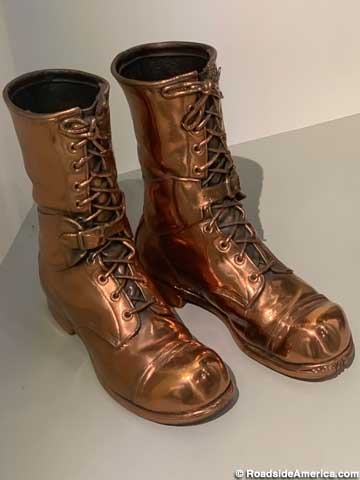
"Jump boots were a symbol of pride for paratroopers." This bronzed pair belonged to Gen. Bill Lee.
"Our young soldiers will ask where that hamburger stand was," said John, since no plaque marks the site. "I tell them, 'You already know where it is. It's where the Hooters is now.'"
One relic of Fort Campbell's radioactive years in the museum is the M28 Davy Crockett atomic mortar. This tactical weapon was designed to give the infantry something to do on the "nuclear battlefield" of the Cold War, on the assumption that blowing up a few small, well-lobbed nukes would discourage the Reds if they tried to launch a ground assault into South Korea or Western Europe. "It's silly to think that a couple of 22-year-old soldiers could say, 'Whoa, look at all those bad guys; we better shoot this thing,'" said John. Another problem was that the nuclear warhead's "danger radius" was 2,500 meters, but the mortar's firing range was only 2,000 meters. "The time of flight was 32 seconds," said John. "I ask our soldiers, 'Do you think you could run 500 meters in 32 seconds?'" (Note: no human ever has.)
Fort Campbell was one of the few U.S. posts with units trained to use the atomic mortar. John said that as far as he knew only one museum visitor ever admitted to working with the weapon, which, like the atomic cannon, was test-fired just once before it was retired from service. Although 2,100 Davy Crocketts were built, a mere handful escaped the scrap heap. The one in the Pratt Museum looks mushroom-cloud ready.
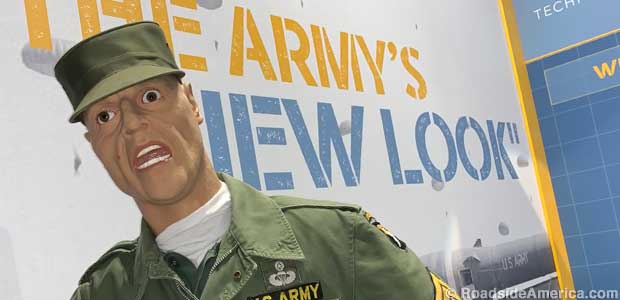
The Army's New Look looked a lot like Sergeant Carter from Gomer Pyle.
Another unique Fort-centered exhibit at the museum is a showcase devoted to "Stockade Annie," an elderly widow who visited the Fort jail for over 25 years. Anna Mabry Barr lived on the farm where the Fort was built, and chased off the first government surveyors with a shotgun. But by 1943 she'd become a Fort fixture, routinely visiting the jail with her Bible, preaching a combination of comfort and tough love. In gratitude, the soldiers filled the black cape that she always wore -- a focal point of the display -- with pinned-on rank insignia, unit crests, qualification badges, and patches from units from World War II, Korea, and Vietnam (Similar to the tribute paid to Owney, the Postal Dog Mascot). Annie died after a bus trip to Washington, DC, in a failed attempt to talk to President Nixon. The Fort general attended her funeral.
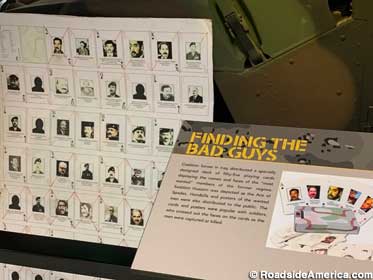
One of the museum's most popular displays brings back memories of Operation Iraqi Freedom.
One of the most visually impressive things about the Pratt Museum is its array of custom soldier dummies. There are Japanese and German paratroopers, North Korean and North Vietnamese infantryman, a Viet Cong insurgent in black pajamas, a pair of Northern Alliance Afghanistan fighters, and a U.S. Army drill sergeant who strongly resembles Sergeant Carter from Gomer Pyle -- played by actor Frank Sutton, who was born in exploding-dog Clarksville.
As for Hitler's walking stick... it was seized in May 1945 when troops from Fort Campbell helped capture Hitler's home in Berchtesgaden. The stick, embellished with medallions representing the 13 European mountains that Hitler had supposedly climbed, is displayed in a small showcase along with other war trophies, such as a fireplace tile depicting a group of flag-waving Hitler Youth. "We kind of avoid trying to highlight Nazi stuff," said John, although the museum has a lot in storage, including a gold goblet that belonged to Hermann Goering and a pair of earmuffs made from the mink bedspread of Eva Braun.
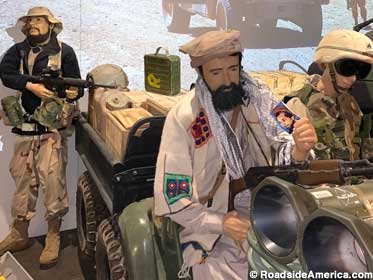
Northern Alliance fighter holds a picture of Ahmed She Massou, assassinated two days before 9/11.
According to John, "if you measure how long people linger at an exhibit," the most popular item in the museum is the "Finding the Bad Guys" chart of Saddam Hussein cronies, most of them crossed off after being captured or killed during Operation Iraqi Freedom. He noted with curatorial pride that everything in the museum is real, including a recreated South Vietnam Fire Base and a D-Day vintage glider that John said he would somehow carry out of the building on his shoulders if there was a fire. The only "fake" artifact is a GI-improvised winter uniform in the museum's siege of Bastogne display. "It's a Hollywood costume, worn by one of the leading guys in Band of Brothers," said John. "We helped them with the script."
John said that as long as Fort Campbell remains open there's no risk of the collection being absorbed into any larger Army museum -- a fate that has befallen other attractions -- and in fact there are future plans to expand Pratt into a mega-museum named "Wings of Victory," over 20 times its current size. It may never tell the story of the exploding dogs, but the new space, whenever it's built, should provide John plenty of room to display all of the artifacts, even the ones from the Nazis.
"In storage we have an SS major general's uniform," John said. "It was captured by the 506th parachute infantry regiment, in a suitcase labeled, 'To Argentina.'"





